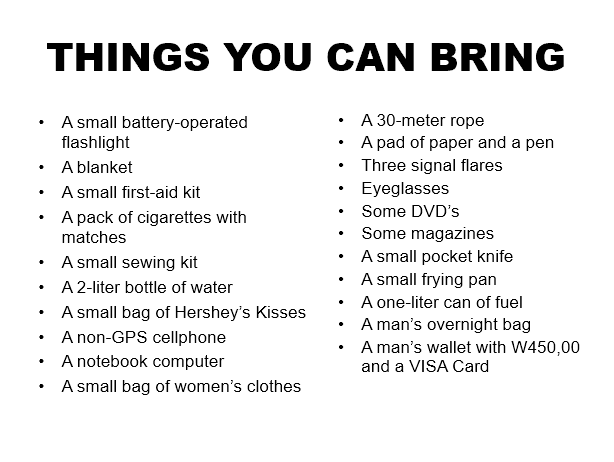Getting a classroom of ESL learners to speak is difficult sometimes. Especially in a mixed-level class, it can be downright challenging. We are going to discuss teaching speaking skills.
This week’s post will provide an activity to get ESL students speaking, develop new vocabulary, and give opportunities for feedback at the same time.
Stranded
This has been a perennial favorite of mine for years. Most seasoned teachers know this or at least a version of it.
There are variations, but the concept is familiar: What do you need to take to a deserted island to survive for an unknown length of time?
I usually have a short PowerPoint presentation set up. But if you’re without technology in the classroom, printed slides will work just as well. If nothing else is available, a whiteboard will do.
I ask students to imagine they’ve decided to get together for a cruise on a yacht. I show a yacht with people on it cruising in the ocean.
Then, boom, they hit something. The boat hull has a hole and is sinking. But they see an island close to them. This is where I show them an image of a deserted tropical island with a few palm trees.
The predicament: They have three minutes to grab what they can, get on a life raft, and make it to the island.
The catch: They have limited space and can’t bring everything they want. They can only bring what they need to survive because they have no idea how long they’ll be there.
Then they get a list of things on the yacht they can bring.
The Twist
This is not just a teamwork activity, but also a class activity. Because once each team has decided on items, the next step is to come back together and convince the other teams their choices are best.
Often, they agree on most items, but there are always a few conflicts that raise interesting discussion.
ESL Games for Teaching Speaking Skills and Writing
Steps
If strictly managed, Stranded can be completed in as little as one 50-minute class. I think two sessions is better, but if your time’s limited, one will have to do.
Let’s go over the steps:
-
-
- Group learners into teams: A, B, C, D, or however you’d like to call them. [5 minutes]
- Tell them the story and what’s expected of them. [5 minutes]
- Display the items to be chosen on-screen, whiteboard, or via handout (one per team).
- Teams are given 10 minutes to discuss their choices with each other. You should be walking around listening to their conversations taking notes for feedback. But focus only on gross or recurring issues (i.e. in grammar, word choices, pronunciation) because you won’t have time to talk about everything. [10 minutes]
- After group choices are made or when time’s up, bring the class back together.
- Each team shares their choices and the teacher displays their choices accordingly. [5 minutes]
- Common items that all teams agree on can be checked off. Items they disagree on will need to be discussed.
- The goal of the team is to convince the others of the wisdom of their choice within 15 minutes! Why? Because the boat is sinking, and they need to bring the items. They may not always agree right away, but those items can be passed and come back to if there’s time (otherwise the opportunity to bring the item is gone). Again, you should note issues for feedback. [15 minutes]
- When time’s up, the boat sinks and the activity is over. Whatever wasn’t agreed on cannot be brought.
- Then give feedback and answer questions. [10 minutes]
-
ESL Games for Teaching Grammar and Vocabulary
 Benefits
Benefits
Every activity in class should have a goal, a purpose, or the desired result. Stranded is no different. There are several benefits associated with this type of activity in general and Stranded in particular. We’ve listed them here.
Strength in Groups
First, class members work in groups. By grouping stronger with weaker language users, they can help the less proficient use English to make their choices. They must also come up with reasons for their choices because later in the activity, they may need to convince members from other groups. So having ideas from all members is a big help.
Get Certified to Teach English Abroad!
No Need to Be Shy
Another benefit of this grouping activity is that the shyer language learners are more inclined to speak. Those who wouldn’t normally speak in class might have a little more confidence using English in smaller groups. The natural result is increased confidence.
More Feedback
A third benefit is more feedback. As a teacher, you can go around and listen to the groups and catch more recurring issues than you could if it were a full class activity. More feedback equals more opportunities to learn and improve.
Speaking Activities for Large ESL Classes
Collaboration
Another benefit is collaboration. By putting members in teams, they’re compelled to agree on the items best for the team instead of themselves as individuals.
This concept is expanded further when each group has to work together toward the common good. Sometimes that may involve individual sacrifice.
The big picture is helping learners understand the concept of giving and take, and at times, agreeing to disagree.
Reduced TTT and Increased STT
One of the main benefits of these activities is that you don’t have to talk too much (keeping teacher talk time low); plus, learners have more opportunities to speak (increased student talk time).
Teaching Speaking Skills: Debates in The ESL Classroom
Focus on Learner Needs
By giving you a chance to observe your students in action, you’ll be able to spot their weak areas. While the speaking activity is taking place, you can take notes of specific areas that can be addressed during feedback time. Notes can be anything involving common grammar, vocabulary, or pronunciation issues.
We say common, because you shouldn’t isolate a single instance. That might identify the class member and lead to shame. We don’t want to embarrass people or make them reluctant to speak in the future.
Wrap Up
There you have it! Classroom activities to improve teaching speaking skills are great strategies to get your students, not only talking but engaged. By discussing choices with team members, and explaining them to others, they’re building their skills in a natural way. When grouping stronger language students with weaker, both can build more confidence.
You’re also giving them opportunities to interact with others, learning how to collaborate and cooperate, even making sacrifices for the good of the group. Teachers can provide more feedback for improving learner English skills. Plus, it’s just fun!
Here are the additional slides in addition to the ones at the beginning of the article:


Give it a try and share your experience with us in the comments.
Related Articles:
Using Boardgames For Fun Speaking And Vocabulary Lessons
ESL Speaking Activity – Daily News






I couldn’t agree more with what you have covered. As an English teacher, this activity is a must-do in my classes since it pushes students to speak and interact with each other. I think every learner’s ultimate goal is to initiate speaking and communicating in the target language. Therefore, this activity can be used as a controversial debate since it’s all about convincing other classmates.
Many thanks.